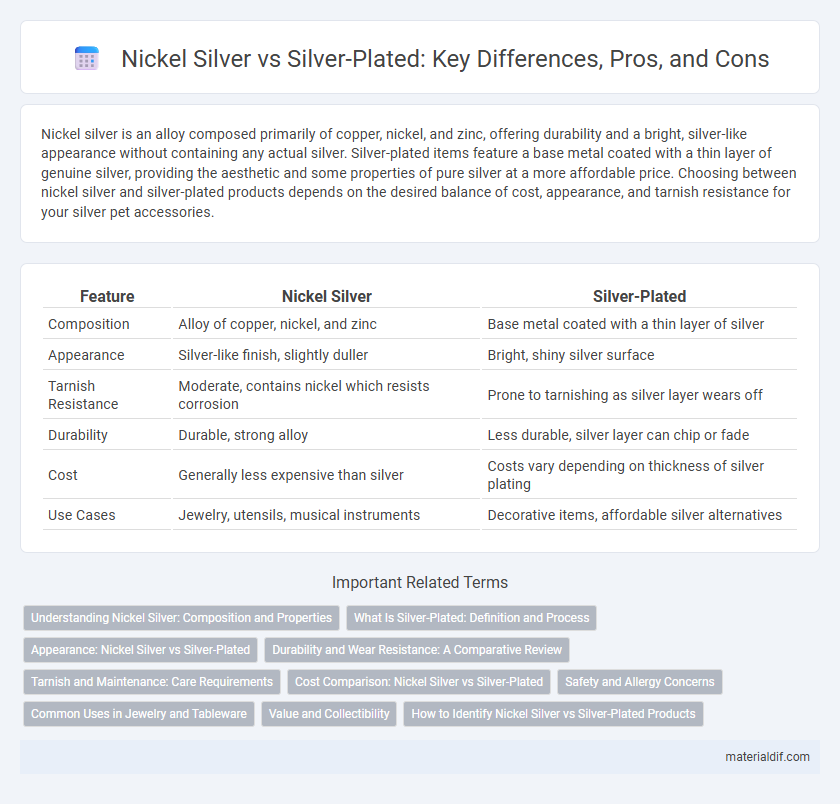Nickel silver is an alloy composed primarily of copper, nickel, and zinc, offering durability and a bright, silver-like appearance without containing any actual silver. Silver-plated items feature a base metal coated with a thin layer of genuine silver, providing the aesthetic and some properties of pure silver at a more affordable price. Choosing between nickel silver and silver-plated products depends on the desired balance of cost, appearance, and tarnish resistance for your silver pet accessories.
Table of Comparison
| Feature | Nickel Silver | Silver-Plated |
|---|---|---|
| Composition | Alloy of copper, nickel, and zinc | Base metal coated with a thin layer of silver |
| Appearance | Silver-like finish, slightly duller | Bright, shiny silver surface |
| Tarnish Resistance | Moderate, contains nickel which resists corrosion | Prone to tarnishing as silver layer wears off |
| Durability | Durable, strong alloy | Less durable, silver layer can chip or fade |
| Cost | Generally less expensive than silver | Costs vary depending on thickness of silver plating |
| Use Cases | Jewelry, utensils, musical instruments | Decorative items, affordable silver alternatives |
Understanding Nickel Silver: Composition and Properties
Nickel silver, also known as German silver, is an alloy primarily composed of copper, nickel, and zinc, typically containing no actual silver despite its name. Its properties include corrosion resistance, durability, and a silvery appearance that makes it a popular choice for affordable decorative items and utensils. Unlike silver-plated items, which have a thin layer of pure silver coating a base metal, nickel silver offers consistent alloy strength throughout without the risk of silver wear-off.
What Is Silver-Plated: Definition and Process
Silver-plated items consist of a base metal coated with a thin layer of pure silver through electroplating or mechanical means. This process enhances the appearance and corrosion resistance of the object while reducing the cost compared to solid silver. Nickel silver, often confused with silver-plated, contains no actual silver and is an alloy of copper, nickel, and zinc.
Appearance: Nickel Silver vs Silver-Plated
Nickel silver exhibits a duller, grayish tone due to its copper, nickel, and zinc composition, contrasting with the bright, reflective shine characteristic of silver-plated items. Silver-plated surfaces benefit from a high-luster finish that closely resembles pure silver, making them visually more appealing for decorative uses. Over time, nickel silver can develop a patina that adds a matte, antique look, while silver plating tends to maintain its glossy appearance until the thin silver layer wears off.
Durability and Wear Resistance: A Comparative Review
Nickel silver, composed of copper, nickel, and zinc, offers superior durability and wear resistance compared to silver-plated items, which have a thin layer of pure silver over a base metal. Nickel silver resists tarnishing and scratches better, making it ideal for everyday use and high-contact items. Silver-plated objects, while visually appealing, tend to wear down quickly as the silver layer erodes, exposing the underlying base metal.
Tarnish and Maintenance: Care Requirements
Nickel silver, an alloy of nickel, copper, and zinc, is resistant to tarnish and requires minimal maintenance compared to silver-plated items, which have a thin layer of silver prone to corrosion and discoloration over time. Silver-plated objects demand frequent polishing to preserve their shine and prevent oxidation, while nickel silver's durability ensures long-lasting appearance with simple cleaning. The differential care needs make nickel silver more practical for everyday use, whereas silver-plated items are better suited for less frequent handling or decorative purposes.
Cost Comparison: Nickel Silver vs Silver-Plated
Nickel silver offers a more affordable option compared to silver-plated items due to its base metal composition of copper, nickel, and zinc, which reduces production costs significantly. Silver-plated products involve a thin layer of real silver over a less expensive base metal, making them costlier than nickel silver but less expensive than solid silver. Consumers seeking budget-friendly alternatives with a silver appearance often choose nickel silver, while silver-plated pieces provide a higher perceived value at a moderate price.
Safety and Allergy Concerns
Nickel silver, composed mainly of copper, nickel, and zinc, often causes allergic reactions due to its nickel content, which can trigger skin irritation in sensitive individuals. Silver-plated items feature a thin layer of pure silver over a base metal, reducing direct contact with allergenic metals but still posing risks if the plating wears off. Opting for high-quality silver-plated jewelry or pure silver is safer for those prone to metal allergies and minimizes the risk of skin irritation.
Common Uses in Jewelry and Tableware
Nickel silver, an alloy of nickel, copper, and zinc, is widely used in affordable jewelry and durable tableware due to its resistance to tarnish and corrosion. Silver-plated items, featuring a thin layer of pure silver over base metals, are favored for their elegant appearance in decorative tableware and costume jewelry. Both materials offer cost-effective alternatives to solid silver, catering to different aesthetic preferences and functional demands in everyday use.
Value and Collectibility
Nickel silver, an alloy composed mainly of copper, nickel, and zinc, lacks actual silver content, which significantly reduces its intrinsic value compared to silver-plated items that have a thin layer of genuine silver coating. Silver-plated pieces offer higher collectibility due to their silver surface that can be polished to a shine and bear silver hallmarks, enhancing appeal to collectors. Despite this, solid silver items consistently outperform both nickel silver and silver-plated objects in market value and long-term investment potential.
How to Identify Nickel Silver vs Silver-Plated Products
Nickel silver contains no actual silver and is identified by its slightly yellowish or brassy tint, whereas silver-plated items have a thin layer of genuine silver coating a base metal, often showing hallmarks like "925" or "EPNS." Testing methods such as acid tests or magnet tests can differentiate the two; nickel silver is non-magnetic and lacks silver content, while genuine silver plating reacts to silver testing acids and may tarnish differently. Visual inspection for wear and markings, combined with these tests, reliably distinguishes nickel silver from silver-plated products.
Nickel Silver vs Silver-Plated Infographic

 materialdif.com
materialdif.com